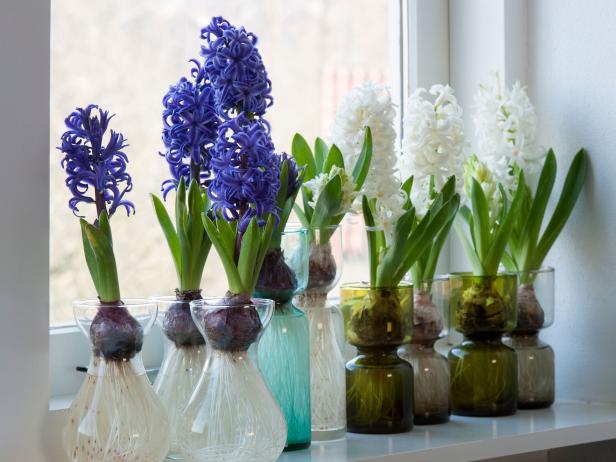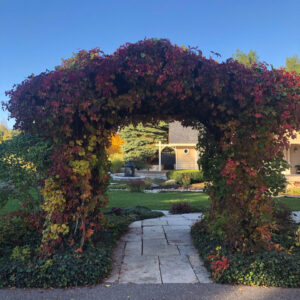By Katie Goulbourne, Master Gardener in Training, SCMG
As the days get shorter and darker and winter heralds cold and snow, gardeners long for some colour and brightness to tide them over. While days are spent dreaming of spring weather ahead, forcing some bulbs indoors can provide a little relief and brighten the house. Let’s look at the most common types of bulbs forced indoors this time of year: Amaryllis, Paperwhite Narcissus and Hyacinth.
Amaryllis
If looking to make an impact, an amaryllis is an excellent choice. The amaryllis we see around during the holidays are hybrids of the genus Hippeastrum, which are native to Central and South America. They are generally available in varying shades of reds, white, pinks, salmons and burgundy. Some speciality varieties are bicolour or picotee, where the edge is a different colour. When choosing a bulb to plant, the condition and size of the bulb will determine how well the bulb will perform. The larger bulbs will produce more stalks and blooms. Ensure that the bulb is firm and free of any mould or soft spots. About six to ten weeks before you want your amaryllis to bloom, plant it in a well draining pot that is about 2 1/2 – 5 cm wider than the widest part of the bulb. The pot should also be about twice the height of the bulb. Fill about half the pot with good potting soil and set the bulb on the soil. The top of the bulb should sit above the edge of the pot. Finish by filling soil around the bulb, ensuring that the top third of the bulb is not covered. Water around the bulb and place it in a sunny location. Ensure that your amaryllis is not over watered as it could cause the bulb to rot. Your amaryllis should provide you with a show of flowers in the coming weeks. Rotating your pot will help form a straighter stalk. Depending on how tall your amaryllis gets, it may require the support of a stake. With some care your amaryllis bulb will bloom again for you next year. Once it has finished blooming, remove the spent flowers and continue to water and fertilize. When warm weather arrives move your potted amaryllis outside, continuing to care for it. Once it turns yellow it can be put in a dark area and left to rest for about 6-8 weeks. When ready to bring it back into the house, the leaves and stalk can be trimmed off and the bulb watered. The amaryllis should reward you with beautiful flowers once again.

Paperwhite Narcissus
Although not as colourful and bold as the Amaryllis, Paperwhites are another easy way to add big impact and fragrance to those long winter days. Paperwhites are native to Mediterranean areas, but here they are best suited to be grown inside. Paperwhites do not need to be placed in cold storage prior to planting. Once planted, they will quickly start to grow and produce small white clusters atop a tall spike in a short time frame. Each flower spike could produce 15 flower heads. Paperwhites can be placed in a shallow bowl with gravel or stones or can be planted with potting soil. If planting in gravel or stones place the bulbs, pointy ends up, on top of gravel and place some of the gravel around the bulbs leaving the tops exposed. Add water up to the bottom of the bulbs, but not to the point that the bulbs are immersed in water. If you prefer to plant in soil, follow the same principles leaving the tops sticking out of the soil. Water around the bulbs, not directly on them, and place in a cool low light area until shoots begin to appear. Once you notice shoots you can move the paperwhites to a warmer and brighter location. The flowers should provide 3-4 weeks of enjoyment. Unfortunately, once they have finished blooming the bulbs can not be saved and should be composted.

Hyacinth
Nothing says spring and cheer more than the sight and scent of colourful hyacinths. Purple, pink, white and blue are the colours synonymous with these fun blooms. Most of these hyacinths are cultivars of Hyacinthus orientalis, commonly known as garden hyacinth. Hyacinths will require a little more planning than amaryllis or paperwhites as they require a chilling period. Bulbs can be chilled prior to planting or can be planted and then chilled. If your bulbs do not come precooled, chill the bulbs in a dark cool area such as a cold room, garage, shed or fridge for about 8 to 12 weeks around 5 degrees celsius (if putting in a fridge ensure they are not kept near apples as they produce ethylene gas which will decrease blooms). Hyacinth bulbs can be forced by planting in soil or growing in a special forcing vase on water. If planting in soil a 4 inch pot would be a good size for a single bulb. Place soil in the bottom of the pot and then add soil around the bulb without covering the tips. For a different and unique presentation an hour glass vase can be used where the bulb is cupped and suspended above water. Ensure that the water is just at the bottom of the bulb and that the bulb is not sitting in the water, which could cause rotting. Once the cooling period is complete, place the bulb in a low light area until it begins to sprout, it can then be moved into a brighter area. A flower stem should reward you in about 2-3 weeks. Forcing hyacinth bulbs requires alot of energy from the bulb and they generally do not do well after they have been forced. Once the flower is finished it can be composted.

Select your favourite bulbs or experiment with something new to help stave off the “winter blues”. With a little effort and planning ahead you will soon be soaking up the beauty and fragrance ofthese bulbs.
Photos:
https://www.dutchgrown.com/blogs/how-to-guides/how-to-grow-hyacinth-in-water




